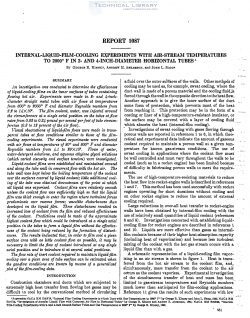naca-report-1087

- Version
- 116 Downloads
- 2.58 MB File Size
- 1 File Count
- September 7, 2016 Create Date
- September 7, 2016 Last Updated
National Advisory Committee for Aeronautics, Report - Internal Liquid Film Cooling Experiments with Air Stream Temperatures to 2000°F in 2'' & 4'' Diameter Horizontal Tubes

An investigation was conducted to determine the qflectireness
0f liquul-coolingfilms on the inner surfaces of tubes containing
flowing hot air. Erperiments were made in 2- and, 4-inch-
diameter straight metal tubes with air flows at temperatures
from 600° to 2000° F and diameter Reynolds numbers from
9.2 to 14X10‘. The film coolant, water, was injected around
the circumference at a single axial position on the tubes at flow
rates from 0 .02 to 0.9 4pound per second per foot of tube circum—
ference (0. 8 to 12 percent of the airflow).
lisual observations of l1qu1d film flows were made in trans-
parent tubes at flow conditions similar to those of the film—
cooli-ng experiments. The visual eaperiments were conducted
with air flows at temperatures of 80° and 800° F and diameter
Reynolds numbers from 4.1 to 29X10‘. flows of water,
water-detergent solutions, and aqueous ethylene glycol solutions
(which varied viscosity and surface tension) were inrestigated.
Liquid-coolan-tfilms were established and maintained around
and along the tube wall in cocurrentflow with the hot air. The
tube wall was kept below the boiling temperature of the coolant
orer the surfaces coeered by liquid coolant; little additional cool—
ing of the tube was obtained downstream of the point at which
all liquid was raporized. Coolant films were relatirely smooth
unless the coolant flow was sujicie-ntly high so that the liquid
film was thick enough to enter the region where turbulent forces
predominate orer mscous forces; unrelilce disturbances then
dereloped on the liquid film. These disturbances resulted in
increased loss of coolant from the film and reduced efectireness
of the coolant. Predictions could be made of the approximate
highest coolant flow which could be introduced at a single arial
position in the tubes to form a liquidfilm without the efl'ectire—
ness of the coolant being reduced by the format-ion of disturb-
ances. The results indicated that, in order to film cool a giren
surface area with as little coolant flow as possible, it may be
necessary to limit the flow of coolant introduced at any single
axial position and to introduce it at sereral axial positions.
The flow rate of inert coolant required to maintain liquidgilm
cooling over a giren area of tube surface can be estimated when
the gas-flow conditions are known by means of a generalized
plot of the film-cooling data.
| File | Action |
|---|---|
| naca-report-1087 Internal Liquid Film Cooling Experiments with Air Stream Temperatures to 2000°F in 2'' & 4'' Diameter Horizontal Tubes.pdf | Download |

Comment On This Post